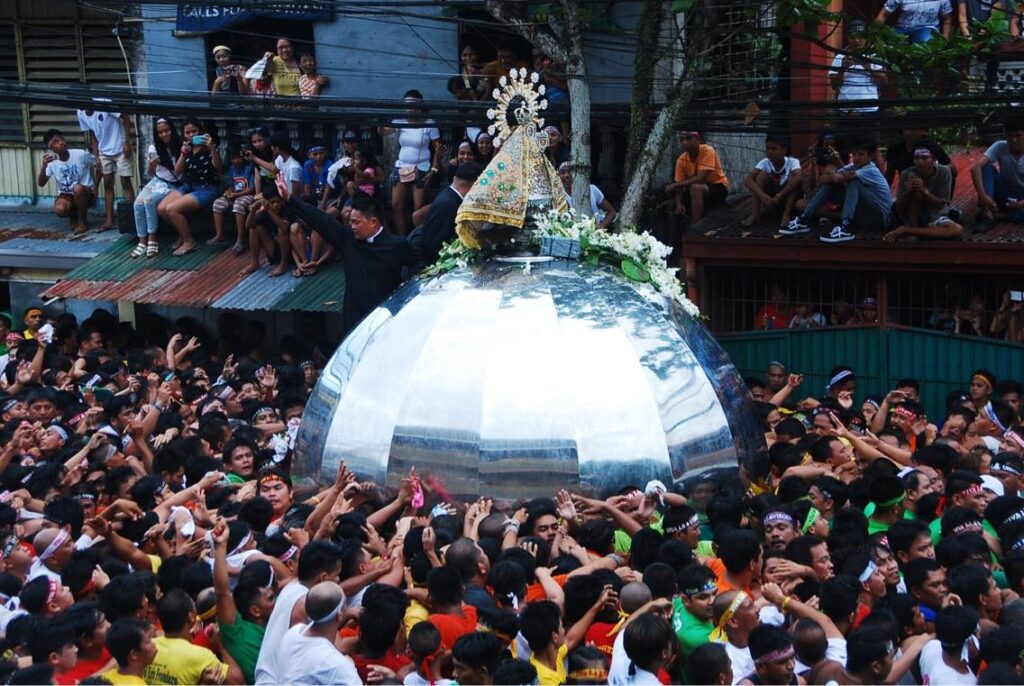Traslacion as procession of Catholic faith

The Our Lady of Peñafrancia whose feast day is celebrated in Naga City this September. | Inquirer.net File Photo
There are two popular festivals in the Philippines that have procession called “Traslacion,” which in Spanish means “passage” or “moving something from one place to another”: the Black Nazarene in Manila and Penafrancia in Naga City, Bicol.
The Traslación in Manila is held every January 9 as a re-enactment of the “solemn transfer” from Intramuros to Quiapo Church of the Black Nazarene’s replica image which was brought to the Philippines in 1606. It depicts Jesus en route to his crucifixion.
In 1608, the icon was enshrined at the Recollect church of San Nicolás de Tolentino in Intramuros. It was moved to the Saint John the Baptist Church (now known as the Quiapo Church) on January 9, 1787.
On the other hand, Naga City has two Traslacions every September for the transfer from the Basilica to Naga Cathedral and back of the Divino Rostro (Divine Face of Jesus) and “Ina” , or Our Lady of Peñafrancia, patroness of the Bicol region.
The Peñafrancia Festival, which has been described as the biggest Marian event in Asia, is a celebration of two feasts—Divino Rostro on the second Friday of September, and Our Lady of Peñafrancia the next weekend.
The second Traslacion has a Fluvial procession as Divino Rostro and Ina traverse the Naga River on their journey back to the Basilica Minore after the nine-day novena at the Naga Cathedral.
The 2012 Quiapo Traslación is the longest in the image’s recorded history as it ended 22 hours after leaving the Grandstand, arriving at Plaza Miranda around 5:15 a.m. the next day (January 10).
Filipino Catholics are known for having sincere, enormous and extreme expressions of piety considering that the country is the third-largest Catholic population in the world.
The fervent devotion and faith shown by devotees became a prime manifestation of the fusion of Catholic and secular beliefs and practices of Filipinos.
In both festivals, large crowds donned in predominantly maroon and yellow shirts wave white towels in the air as they forcefully gathered towards the carriage called “andas” as it crawled through the generally narrow roads of the city.
Many devotees join the processions as part of their panata (vow) which is usually carried out as a plea to God or as thanksgiving for healing, blessing or granting of/granted wish.
They believe that walking barefoot, wiping the image with the towels, holding and pulling the rope of the andas, and even climbing the carriage, will get them closer to achieving their prayers.
Walking barefooted is a symbolic gesture that emulates Christ’s suffering as he was carrying his cross to Golgotha.
Devotees use physical force to aggressively touch the image mounted on the carriage andas.
The mass gatherings like the Traslacions attract severe health and safety risks due to pedestrian abnormal behavior, such as crowd crush, panic stampedes and turbulence.
Injuries and even death seem to be common occurrences brought upon by several factors including heat, fatigue, or being trampled upon by the crowd.
A crowd crush is created by the press of human bodies on a central point or points. Crowd crush occurs when a group of people is packed so close together that no one can move and they keep pushing, causing the crowd to fall in a “domino effect” making it hard to get up.
On the other hand, stampedes are usually created when a crowd starts fleeing from danger or a perceived danger.
Although I am from Manila, I have not seen the Quiapo Traslacion in person. Ironically, I travelled to Naga City to participate in the Penafrancia festival in 2016.
I originally planned to be a mere bystander and watch the “voyadores” send INA to the pier. But before i knew it I was pushed towards INA’s andas until I got trapped inside ranks of the voyadores.
At first I attempted to get out but to no avail. There was no room for me to leave. The crowd was in a “hysteria-like” state. I felt the pushing, the sweat and the adrenalin rush of the devotees.
Panic and fear replaced my excitement when I felt that I cannot breathe. I tried to get out but I could not. I was on the verge of crying or collapsing due to the chaos.
My fear became a reality: I fell down and felt the pain of being stepped upon by several voyadores. Then some voyadores pulled me out and covered me and told me to crawl out. And I did. Traumatized, I just sat at the side watching with amazement how I survived the anarchy.
For those caught in a crush, one must stay on their feet, adopting a boxer’s stance to maintain balance and keeping hands up by one’s chest to protect breathing space.
One must not resist the force of the crowd, but instead try to move diagonally to the edge of the crowd when there is a lull in movement.
If one falls down, one has to curl into a ball to try to protect oneself.
Proper risk management planning for these festivities is imperative to minimize the incidence of injuries and deaths.
Viva La Virgen Penafrancia.
(Atty. Dennis R. Gorecho heads the seafarers’ division of the Sapalo Velez Bundang Bulilan law offices. For comments, e-mail [email protected], or call 09175025808 or 09088665786.)
Disclaimer: The comments uploaded on this site do not necessarily represent or reflect the views of management and owner of Cebudailynews. We reserve the right to exclude comments that we deem to be inconsistent with our editorial standards.
